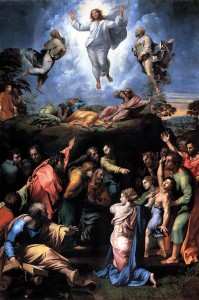
Recently, I attended a talk about beauty. After asking his listeners about various things that they found beautiful (stars, music, the ocean), the speaker—a priest—presented us with online images of two works of art: an abstract composition by Piet Mondrian and the Transfiguration by Raphael. “Tell me which you think is more beautiful,” he said.
Although geometry and order are wonderful things, we all agreed that we didn’t find Mondrian’s work particularly pleasing. “All right, let’s change this up,” our speaker said, replacing Mondrian’s collection of rectangles and squares with an Afremovian splash of color. Comparing Leonid Afremov’s modern-impressionist rain scene with Raphael’s Renaissance work, he asked us again, “Now which do you think is more beautiful?

After a moment of scrutiny, a girl in front of me pointed to the Afremov. “I like this one,” she declared.
“Why?” the priest asked her.
“Well,” considered the girl, “It deals with the subject more originally. I feel like there are a lot of other paintings that look like Raphael’s.”
Her friend sitting next to her agreed. “I love rain,” she said, “and I love color. So looking at this painting makes me happy.”

“I still think Raphael’s is more beautiful,” another listener quickly pointed out. “It shows a much deeper meaning than the other painting.”
Both parts of the argument had legitimate points. Beauty can be a difficult thing to discuss. During our comparison of the two paintings, we made several observations about beauty in art.
One of our more confusing questions was that if beauty comes from God, how can one thing be more beautiful to some people than others? There were people who enjoyed Afremov’s painting, but others couldn’t stand it. Can beauty be subjective?
It’s true that everyone has different personalities, preferences, and even memories that will influence how they see things. For example, though my personality may make me apt to grumble about rainy days, the girl’s friend in the discussion above may have happy memories of playing outside when it rained. Or she might make some connections, such as that between rainfall and God’s grace, which I might fail to make. As a result, she may have liked Afremov’s painting more than I did. Each of us is created to be wonderfully unique, and thus we might see different elements of beauty in different things.
That having been said, beauty is not just a personal preference. The concept of beauty should be kept separate from that of simply attractiveness. St. Thomas Aquinas wrote that how truly beautiful something is depends in part on how well it expresses its essence, the truth of what it is. Our speaker also observed that truth, which comes from the indivisible God, is interconnected with beauty, which comes from the same indivisible God. So there is a certain objectivity about beauty, which we can take into consideration when looking at art. In the context of our art comparison, the Transfiguration’s style and subject matter bring our thoughts more directly to God than does Afremov’s portrayal of creation.
A brief note on medium. As implied above, how the subject matter is portrayed is significant to artwork’s beauty. Raphael’s exquisite rendering of nature and the human body add to his work’s loveliness and makes it easier to appreciate his subject. In fact, if art with a beautiful subject matter isn’t very pleasing, it’s probably because of the artist’s own failure to express its beauty and point viewers to God.
Finally, it’s very important to consider the effect of novelty. Many times I’ve highly enjoyed a film after watching it for the first time. But after a few run-throughs, I can see deficiencies in plot and acting, and find that the jokes I thought were funny are actually somewhat flat. This can be applied to art as well—don’t rely too much on first impressions. While we might not get particularly tired of looking at Afremov’s composition, someday we will probably run out of meaning to extract from it. On the other hand, Raphael’s Transfiguration skillfully depicts a sublime scene with connections to several stories and truths. The Transfiguration of Christ is a divine mystery, and so there is an indefinite amount of understanding to glean from it. The girl who found Raphael’s painting unoriginal at first may find that the more thoughtfully she looks at it, the more it will lead her to contemplate its divine subject, God, who is Beauty itself.
So which work did we decide to call more beautiful? For many reasons we generally came to agree that this title belonged to Raphael’s painting. But if you didn’t want to commit, you could always take the side of the religious sister in Father’s audience who, on being asked which painting was more beautiful, always said, “Both.”





